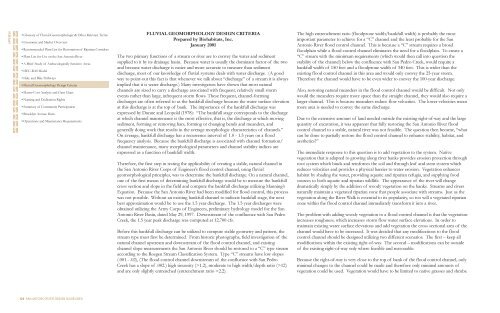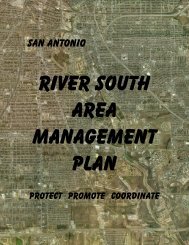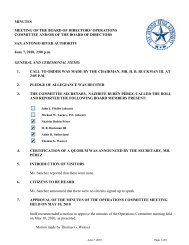concept design san antonio river improvements project
concept design san antonio river improvements project
concept design san antonio river improvements project
Create successful ePaper yourself
Turn your PDF publications into a flip-book with our unique Google optimized e-Paper software.
APPENDIX<br />
• Glossary of Fluvial Geomorphologic & Other Relevant Terms<br />
• Economic and Market Overview<br />
• Recommended Plant List for Restoration of Riparian Corridors<br />
• Plant List for Use on the San Antonio River<br />
• A Brief Study of Archaeologically Sensitive Areas<br />
• HEC-RAS Model<br />
• Hike and Bike Pathways<br />
• Fluvial Geomorphology Design Criteria<br />
• Master Cost Analysis and Gant Chart<br />
• Naming and Dedication Rights<br />
• Summary of Community Participation<br />
• Brooklyn Avenue Dam<br />
• Operations and Maintenance Requirements<br />
126 SAN ANTONIO RIVER DESIGN GUIDELINES<br />
FLUVIAL GEOMORPHOLOGY DESIGN CRITERIA<br />
Prepared by Biohabitats, Inc.<br />
January 2001<br />
The two primary functions of a stream or <strong>river</strong> are to convey the water and sediment<br />
supplied to it by its drainage basin. Because water is usually the dominant factor of the two<br />
and because water discharge is easier and more accurate to measure than sediment<br />
discharge, most of our knowledge of fluvial systems deals with water discharge. (A good<br />
way to point-out this fact is that whenever we talk about “discharge” of a stream it is always<br />
implied that it is water discharge.) Many investigators have shown that most natural<br />
channels are sized to carry a discharge associated with frequent, relatively small storm<br />
events rather than large, infrequent storm flows. These frequent, channel-forming<br />
discharges are often referred to as the bankfull discharge because the water surface elevation<br />
at this discharge is at the top of bank. The importance of the bankfull discharge was<br />
expressed by Dunne and Leopold (1978): “The bankfull stage corresponds to the discharge<br />
at which channel maintenance is the most effective, that is, the discharge at which moving<br />
sediment, forming or removing bars, forming or changing bends and meanders, and<br />
generally doing work that results in the average morphologic characteristics of channels.”<br />
On average, bankfull discharge has a recurrence interval of 1.0 - 1.5 years on a flood<br />
frequency analysis. Because the bankfull discharge is associated with channel formation/<br />
channel maintenance, many morphological parameters and channel stability indices are<br />
expressed as a function of bankfull width.<br />
Therefore, the first step in testing the applicability of creating a stable, natural channel in<br />
the San Antonio River Corps of Engineer’s flood control channel, using fluvial<br />
geomorphological principles, was to determine the bankfull discharge. On a natural channel,<br />
one of the first means of determining bankfull discharge would be to measure the bankfull<br />
cross section and slope in the field and compute the bankfull discharge utilizing Manning’s<br />
Equation. Because the San Antonio River had been modified for flood control, this process<br />
was not possible. Without an existing bankfull channel to indicate bankfull stage, the next<br />
best approximation would be to use the 1.5 year discharge. The 1.5 year discharges were<br />
obtained utilizing the Army Corps of Engineers, preliminary hydrology model for the San<br />
Antonio River Basin, dated May 29, 1997. Downstream of the confluence with San Pedro<br />
Creek, the 1.5 year peak discharge was computed at 12,700 cfs.<br />
Before this bankfull discharge can be utilized to compute stable geometry and pattern, the<br />
stream type must first be determined. From historic photographs, field investigation of the<br />
natural channel upstream and downstream of the flood control channel, and existing<br />
channel slope measurements the San Antonio River should be restored to a “C” type stream<br />
according to the Rosgen Stream Classification System. Type “C” streams have low slopes<br />
(.001 - .02), (The flood control channel downstream of the confluence with San Pedro<br />
Creek has a slope of .002.) high sinuosity (>1.2), moderate to high width/depth ratio (>12)<br />
and are only slightly entrenched (entrenchment ratio >2.2).<br />
The high entrenchment ratio (floodprone width/bankfull width) is probably the most<br />
important parameter to achieve for a “C” channel and the least probable for the San<br />
Antonio River flood control channel. This is because a “C” stream requires a broad<br />
floodplain while a flood control channel eliminates the need for a floodplain. To create a<br />
“C” stream with the minimum requirements (which would then call into question the<br />
stability of the channel) below the confluence with San Pedro Creek, would require a<br />
bankfull width of 150 feet and a floodprone width of 340 feet. This is wider than the<br />
existing flood control channel in this area and would only convey the 25-year storm.<br />
Therefore the channel would have to be even wider to convey the 100-year discharge.<br />
Also, restoring natural meanders in the flood control channel would be difficult. Not only<br />
would the meanders require more space than the straight channel, they would also require a<br />
larger channel. This is because meanders reduce flow velocities. The lower velocities mean<br />
more area is needed to convey the same discharge.<br />
Due to the extensive amount of land needed outside the existing right-of-way and the large<br />
quantity of excavation, it was apparent that fully restoring the San Antonio River flood<br />
control channel to a stable, natural <strong>river</strong> was not feasible. The question then became, “what<br />
can be done to partially restore the flood control channel to enhance stability, habitat, and<br />
aesthetics?”<br />
The immediate response to this question is to add vegetation to the system. Native<br />
vegetation that is adapted to growing along <strong>river</strong> banks provides erosion protection through<br />
root system which binds and reinforces the soil and through leaf and stem system which<br />
reduces velocities and provides a physical barrier to water erosion. Vegetation enhances<br />
habitat by shading the water, providing aquatic and riparian refugia, and supplying food<br />
sources to both aquatic and riparian wildlife. The appearance of the <strong>river</strong> will change<br />
dramatically simply by the addition of woody vegetation on the banks. Streams and <strong>river</strong>s<br />
naturally maintain a vegetated riparian zone that people associate with streams. Just as the<br />
vegetation along the River Walk is essential to its popularity, so too will a vegetated riparian<br />
zone within the flood control channel immediately transform it into a <strong>river</strong>.<br />
The problem with adding woody vegetation to a flood control channel is that the vegetation<br />
increases roughness, which increases storm flow water surface elevations. In order to<br />
maintain existing water surface elevations and add vegetation the cross sectional area of the<br />
channel would have to be increased. It was decided that any modifications to the flood<br />
control channel should be <strong>design</strong>ed utilizing two different scenarios. The first – keep all<br />
modifications within the existing right-of-way. The second – modifications can be outside<br />
of the existing right-of-way only where feasible and reasonable.<br />
Because the right-of-way is very close to the top of bank of the flood control channel, only<br />
minimal changes to the channel could be made and therefore only minimal amounts of<br />
vegetation could be used. Vegetation would have to be limited to native grasses and shrubs.






